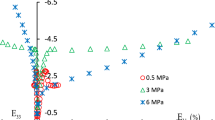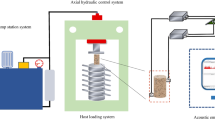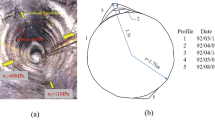Abstract
This paper reports the results of thermal spallation experiments on specially dried shale samples with 3 bedding orientations (0°, 45° and 90°) under 3 flame temperatures (899 °C, 1243 °C and 1559 °C) and the 3D thermal elastic finite element modelling. Under open flame heating, continuous spallation is observed with ejection of various spalls and popping sounds. After a period of spallation, tensile fractures are formed in the samples and grow perpendicular to the heating surface, except for a sample with bedding orientation of 90° under the low temperature. Increasing flame temperature promotes ejection, popping sounds and spallation rate, but reduces the spallation starting time, spallation duration, depression diameter and depression depth. The model shows that heating induces compressive stress in the surface layer and tensile stresses beneath it. The tensile stress is found to be sufficient to generate large tensile fractures. The ratio between the induced compressive and tensile stresses increases with increasing spallation depth but little affected by the flame temperature. The spallation compressive stress increases with temperature from 29 to 51% of the uniaxial compressive strength. This stress is shown to be sufficient to cause buckling of thin layers separated from the bulk of the rock. The size of the buckling layer is smaller than the size of the spallation zone leading to a mosaic pattern seen on the surface after spallation. The results are important for further understanding of the mechanism of thermal spallation of rocks as well as large scale spallation-like processes in the Earth’s crust.


























Similar content being viewed by others
Data availability
The datasets generated during and/or analysed during the current study are available from the corresponding author on reasonable request.
References
Andersson JC, Martin CD, Stille H (2009) The Äspö pillar stability experiment: Part II—rock mass response to coupled excavation-induced and thermal-induced stresses. Int J Rock Mech Min Sci 46(5):879–895
Deng H, Jia L (2022) Key technologies for drilling deep and ultra-deep wells in the Sichuan Basin: current status, challenges and prospects. Nat Gas Ind 42(12):82–94
Dong LL, Leung CW, Cheung CS (2004) Heat transfer and wall pressure characteristics of a twin premixed butane/air flame jets. Int J Heat Mass Transf 47(3):489–500
Dyskin A, Pastenak E, Wang H, Dight P (2020) Skin rockbursts and microseismicity in underground mining. In: EAGE 2020 Annual Conference & Exhibition Online, vol. 2020, p. 1–5
Freeman D, Sawdye J, Mumpton F (1963) The mechanism of thermal spalling in rocks. Colo Sch Mines Q 58(4):225–252
Germanovich L (1997) Thermal spalling of rock. Adv Fract Res 6:2771–2782
Guo Y, Huang L, Li X, Chen J, Sun J (2020) Experimental investigation on the effects of thermal treatment on the physical and mechanical properties of shale. J Nat Gas ScI Eng 82:103496
Guo Y, Li X, Huang L, Liu H, Wu Y (2021) Effect of water-based working fluid imbibition on static and dynamic compressive properties of anisotropic shale. J Nat Gas Sci Eng 95:104194
Guo Y, Li X, Huang L (2022) Changes in thermophysical and thermomechanical properties of thermally treated anisotropic shale after water cooling. Fuel 327:125241
Guo Y, Huang L, Li X (2023) Experimental investigation of the tensile behavior and acoustic emission characteristics of anisotropic shale under geothermal environment. Energy 263:125767
Guo Y, Dyskin A, Pasternak E (2024) Thermal spallation of dry rocks induced by flame parallel or normal to layering: effect of anisotropy. Energy 288:129697
Hasenjäger (1935) Zur Frage der Abplatzungen an Betonbauteilen aus Normalbeton bei Brandbeans- pruchung. Braunshweig, Germany
He MC, Miao JL, Feng JL (2010) Rock burst process of limestone and its acoustic emission characteristics under true-triaxial unloading conditions. Int J Rock Mech Min Sci 47(2):286–298
He X, Chen G, Wu J, Liu Y, Wu S, Zhang J, Zhang X (2023) Deep shale gas exploration and development in the southern Sichuan Basin: new progress and challenges. Nat Gas Ind B 10(1):32–43
Hertz KD (2003) Limits of spalling of fire-exposed concrete. Fire Saf J 38(2):103–116
Hertz KD, Sørensen LS (2005) Test method for spalling of fire exposed concrete. Fire Saf J 40(5):466–476
Hu X, Song X, Liu Y, Li G, Shen Z, Lyu Z (2018) Aspect ratio of spalls of granite in flame-jet spallation and its effect on the modeling prediction of spallation properties. J Petrol Sci Eng 171:1390–1399
Huang L, Guo Y, Li X (2022) Mechanical response to dynamic compressive load applied to shale after thermal treatment. J Nat Gas Sci Eng 102:104565
Jaeger JC, Cook NGW, Zimmerman R (2009) Fundamentals of rock mechanics. Wiley-Blackwell, London, Oxford
Jansson R, Boström L (2009) The influence of pressure in the pore system on fire spalling of concrete. Fire Technol 46(1):217
Kant MA, von Rohr PR (2016) Minimal required boundary conditions for the thermal spallation process of granitic rocks. Int J Rock Mech Min Sci 84:177–186
Kant MA, Rossi E, Madonna C, Hoser D, von Rohr PR (2017) A theory on thermal spalling of rocks with a focus on thermal spallation drilling. J Geophys Res-Solid Earth 122(3):1805–1815
Kendrick KJ, Partin CA, Graham RC (2016) Granitic boulder erosion caused by chaparral wildfire: implications for cosmogenic radionuclide dating of bedrock surfaces. J Geol 124(4):529–539
Khor HC, Dyskin AV (2003) Mechanisms of thermal fracturing and spallation in cementicious materials. Aust J Mech Eng 1(1):1–4
Kömle NI, Weiss P, Yung KL (2008) Considerations on a suction drill for lunar surface drilling and sampling: i feasibility study. Acta Geotech 3(3):201–214
Lyu Z, Song X, Li G, Wang G, Shi Y, Liu Y, Zheng R (2018) Experimental analysis on characteristics of micro-structure and mineralogy changes in thermal spallation drilling. J Petrol Sci Eng 167:100–109
Maier M, Saxer A, Bergmeister K, Lackner R (2020) An experimental fire-spalling assessment procedure for concrete mixtures. Constr Build Mater 232:117172
Martin CD, Kaiser PK, McCreath DR (1999) Hoek–Brown parameters for predicting the depth of brittle failure around tunnels. Can Geotech J 36(1):136–151
Martin CD, Christiansson R (2009) Estimating the potential for spalling around a deep nuclear waste repository in crystalline rock. Int J Rock Mech Min Sci 46(2):219–228
Miura T, Nakamura H, Yamamoto Y (2023) Expansive spalling mechanism of concrete due to high temperature based on developed hygro-thermal-mechanical model by 3D-RBSM-TNM. Eng Fract Mech 284:109216
Pelli F, Kaiser PK, Morgenstern NR (1991) An interpretation of ground movements recorded during construction of the Donkin-Morien tunnel. Can Geotech J 28(2):239–254
Preston F, White H (1934) Observations on spalling. J Am Ceram Soc 17(1–12):137–144
Qi Y, Fan S, Yu L Innovation and practice of efficient drilling technology for deep shale gas. In: 11th Asia-Pacific Shale & Unconventional Resources Summit. Shanghai vol. 2021, p. 49–54
Rauenzahn R, Tester J (1985) Flame-jet induced thermal spallation as a method of rapid drilling and cavity formation. In: SPE Annual Technical Conference and Exhibition, Las Vegas, Nevada SPE-14331-MS
Read RS, Chandler NA, Dzik EJ (1998) In situ strength criteria for tunnel design in highly-stressed rock masses. Int J Rock Mech Min Sci 35(3):261–278
Rossi E, Jamali S, Saar MO, Rudolf von Rohr P (2020) Field test of a combined thermo-mechanical drilling technology. Mode I: thermal spallation drilling. J Pet Sci Eng 190:107005
Semnani SJ, White JA, Borja RI (2016) Thermoplasticity and strain localization in transversely isotropic materials based on anisotropic critical state plasticity. Int J Numer Anal Meth Geomech 40(18):2423–2449
Smith A, Pells P (2008) Impact of fire on tunnels in Hawkesbury sandstone. Tunn Undergr Space Technol 23(1):65–74
Sun Q, Liu Y, Shen Z, Han Y, Wang Q, Liu P (2022) A combined thermal spallation and melting technology by plasma jet for deep and hard rock reservoirs. SPE J 28(1):49–63
Thirumalai K (1969) Process of thermal spalling behavior in rocks an exploratory study. In: The 11th U.S. Symposium on Rock Mechanics (USRMS), Berkeley, California: ARMA-69–0705
Timoshenko SP, Gere JM (1961) Theory of elastic stability, 2nd edn. McGraw-Hill Book Company, New York
Vogler D, Walsh SDC, von Rohr PR, Saar MO (2020) Simulation of rock failure modes in thermal spallation drilling. Acta Geotech 15(8):2327–2340
Walsh SDC, Lomov IN (2013) Micromechanical modeling of thermal spallation in granitic rock. Int J Heat Mass Transf 65:366–373
Walsh SDC, Lomov IN, Wideman TW, Potter JM (2014) Size dependent spall aspect ratio and its effects in thermal spallation. Int J Rock Mech Min Sci 70:375–380
Wang G, Radziszewski P, Ouellet J (2008) Particle modeling simulation of thermal effects on ore breakage. Comput Mater Sci 43(4):892–901
Wang H, Dyskin A, Pasternak E, Dight P, Jeffcoat-Sacco B (2022) Fracture mechanics of spallation. Eng Fract Mech 260:108186
Wilkinson MA, Tester JW (1993) Experimental measurement of surface temperatures during flame-jet induced thermal spallation. Rock Mech Rock Eng 26(1):29–62
Williams R, Dey T, Rauenzahn R, Kranz R, Tester J, Potter R, Murphy H (1988) Advancements in thermal spallation drilling technology. Los Alamos National Lab, NM (USA). LA-11391-MS
Zeiml M, Lackner R, Mang HA (2009) Experimental insight into spalling behavior of concrete tunnel linings under fire loading. Acta Geotech 3(4):295–308
Zhao Y, Borja RI (2022) A double-yield-surface plasticity theory for transversely isotropic rocks. Acta Geotech 17(11):5201–5221
Zhen HS, Chen KD, Chen ZB, Wei ZL, Fu LR (2023) Heat transfer analysis of impinging flames using field synergy principle. Case Stud Therm Eng 43:102807
Zheng S, Xie X, Luo L, Jing Y, Tang M, Yang R, Zhong G, Wang J, Chen Z (2019) Fast and efficient drilling technologies for deep shale gas horizontal wells in the Sichuan Basin: a case study of Well Lu 203. Nat Gas Ind 39(7):88–93
Acknowledgements
YG thanks the China Scholarship Council for overseas study support (No. 202106370160). AVD and EP acknowledge support from the Australian Research Council through project DP210102224. We also want to thank Mr. Shili Li for his help on our experimental work and thank the UWA IT service for providing the calculating platform.
Author information
Authors and Affiliations
Corresponding authors
Ethics declarations
Conflict of interest
The authors declare that they have no known competing financial interests or personal relationships that could have appeared to influence the work reported in this paper.
Additional information
Publisher's Note
Springer Nature remains neutral with regard to jurisdictional claims in published maps and institutional affiliations.
Rights and permissions
Springer Nature or its licensor (e.g. a society or other partner) holds exclusive rights to this article under a publishing agreement with the author(s) or other rightsholder(s); author self-archiving of the accepted manuscript version of this article is solely governed by the terms of such publishing agreement and applicable law.
About this article
Cite this article
Guo, Y., Dyskin, A., Pasternak, E. et al. Mechanics of thermal spallation and fracturing of dry rocks produced by surface heating. Acta Geotech. (2024). https://doi.org/10.1007/s11440-024-02260-9
Received:
Accepted:
Published:
DOI: https://doi.org/10.1007/s11440-024-02260-9




